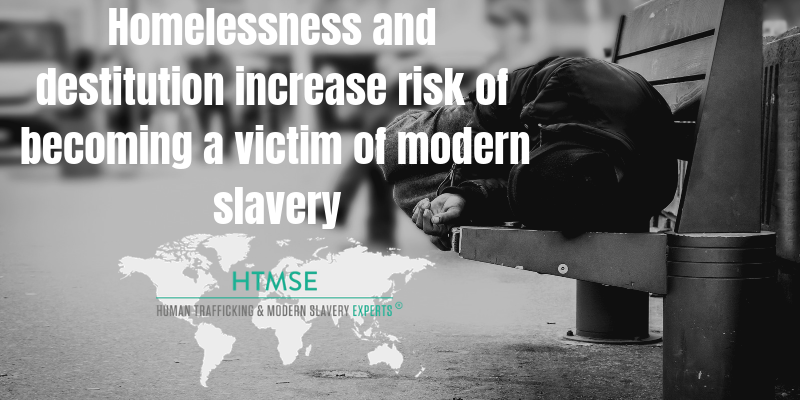
A

A

Europol plays a critical role in combating crime rings within Europe through international cooperation. It provides a centre for law enforcement expertise and international data exchange. Combating human trafficking is one of its five core security priorities, with an aim to disrupt organised crime groups involved in the trafficking of people in and out of the EU. Trafficking is often disguised by legal business structures that directly or indirectly facilitate exploitation. The report, Criminal Networks Involved in the Trafficking and Exploitation of Underage Victims in the European Union analyses data from Europol’s 2015 – 2017 findings in relation to child trafficking.
Although a wide demographic is affected by human trafficking, minors are the most extremely vulnerable sector of society. Children are often lured into sexual, labour or other forms of exploitation, and as a result suffer severe physical and psychological damage.
Unaccompanied minors that may be in the process of migration or orphans, are common trafficking victims that need protection from state and law enforcement actors. However one of the most concerning complexities within the regulation of child trafficking, is the role of families in facilitating the sale or exploitation of their own children. The ‘private’ nature of families forms a protective shield against reporting or disclosure of the child’s wellbeing.
In a similar respect, legal businesses such as brothels, red light districts, sex clubs, within some EU states facilitate the exploitation of minor victims. However recruitment processes are shifting, with the use of online advertisement of sexual services being used as a major platform for the exploitation of children, whereby they are ‘sold’ as adults. Cyber security is another core sector of focus for Europol that intercepts with the issue of child trafficking.
Document and identity fraud for fake identification of minors is a core component of child trafficking to conceal the minor’s real age. In tracing the international movement of victims and traffickers, Europol plays a key role working between EU states to intercept organised crime gangs working internationally.
It is clear that Europol’s role in EU state to state data sharing and law enforcement cooperation is critical. The consequences of Brexit must be considered in terms of regulating international security threats. The UK is the second largest contributor to Europol’s information systems, and currently leads the teams on human trafficking and modern slavery. Ceasing the UK’s involvement in Europol’s affairs may have downstream effects on the capacity to respond effectively to such issues.
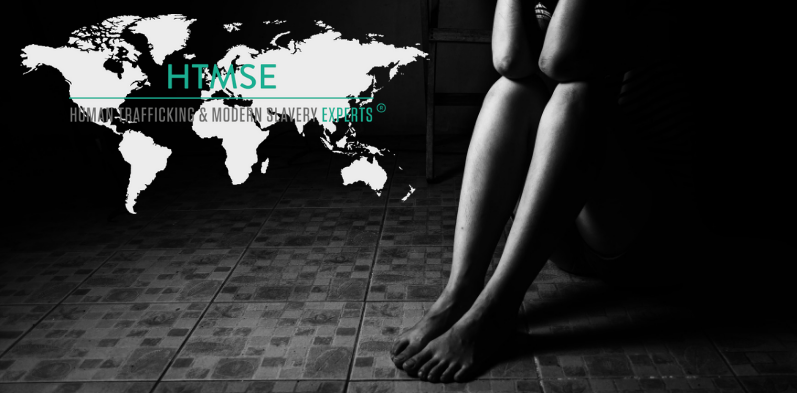
The UK, Australia, Canada, New Zealand and the USA have made progress in the movement to expel modern slavery and labour exploitation from global supply chains.
These five partner countries have created a set of 4 principles designed for nations all over the world to adopt, in order to promote ethical supply chain compliance within their jurisdictions. The principles are aimed at policy level, addressing both public and private sector procurement, supply chains, recruitment and encourages the need for cooperation between such actors.
The four principles are as follows:
Governments should take steps to prevent and address human trafficking in government procurement practices
Governments should encourage the private sector to prevent and address human trafficking in its supply chains
Governments should advance responsible recruitment policies and practices
Governments should strive for harmonisation
The UK, leading global efforts in anti-slavery policy, is encouraging governments at the UN General Assembly to adopt these principles. By leveraging the combined $600 billion purchasing power of the partnered nations there is the capital to influence high-level actors in both public and private sectors.
The principles provide a clear and progressive framework for cooperating governments to aim towards. The major drawback, however, is the lack of enforcement of these principles, which in many instances is controlled by legislation. However, for these principles to be effective in practice rather than theory, strict and coherent sanctions are critical. The further challenge is to address cross border transactions, and encourage non-cooperative countries that produce the majority of global slavery statistics to adopt and enforce such principles.
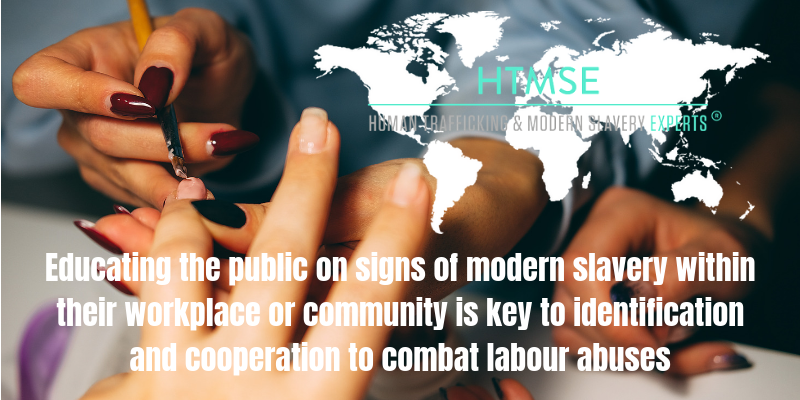
Along with the progress seen in the UK’s legislative framework around human trafficking and modern slavery, there is growing public awareness of the issue. In order for the justice system to work effectively to intercept traffickers, there is demand for the public to be educated on signs of labour abuse, and to work with authorities to report it.
A ground breaking case in January this year led to two traffickers jailed under the Modern Slavery Act for involvement in the trafficking of teenage girls from Vietnam to work unpaid in nail bars in Bath, UK. The importance of this case highlights how victims of slavery can fit into society so blatantly that many people who witness it, do not question the criminality behind it.
UK authorities such as the GLAA have composed toolsets for public education around the identification of modern slavery. Spot the Signs guidance provides clear explanations of human trafficking, forced labour, debt bondage and outlines specific types of exploitation to be aware of, including labour exploitation, sexual exploitation, domestic servitude, organ harvesting and criminal exploitation. The industries regulated by GLAA for forced labour are agriculture, food processing and packaging, construction, warehousing and logistics, service industry and catering, sweatshop manufacturing. As HTMSE have previously noted, there is an ever growing number of target industries for traffickers, including recently recycling and waste processing, football and sports, the beauty and massage industry, as well as a notorious market for forced criminality in cannabis growing operations.
Although each case of labour exploitation will have a variety of variables and indicators, as seen in the Bath case, young, foreign girls who seem fearful or ‘controlled’, and a have language barrier whereby their traffickers can take advantage of them, are potential victims. The GLAA outlines the most common indicators of labour exploitation. In addition to the victim’s characteristics and behaviour, signs to look out for in a victim’s situation are
Unfortunately, once a potential victim is identified, it is not a simple process to restore their freedom. Due to the nature of their mental ‘conditioning’ by the traffickers, Stockholm Syndrome poses a major issue for authorities. If victims do not know they are being exploited or understand their situation, in many cases they are fearful of authorities and will resist cooperation. Spot the Signs highlights the irrelevance of the victim’s “consent” if they are “controlled by force, threats, coercion, abduction, fraud and deception” as it constitutes control over another person. For example, in the Bath case, one of the victims ran away from their foster home to their traffickers within days of release. This is where a victim centred approach, particularly in language services, is critical to consider right from the beginning in the identification of potential victims, and on going in order to ensure successful rehabilitation.
Although the public may not wish to become involved in a case, it is their civic duty if they witness or have suspicion of labour exploitation, to report it. In order to encourage the reporting of modern slavery suspicions, authorities should safeguard interests by maintaining anonymity and providing comprehensive, simple reporting methods. Educating the public on the signs of modern slavery within their workplace or community is key to identification and active public cooperation to combat labour abuses.
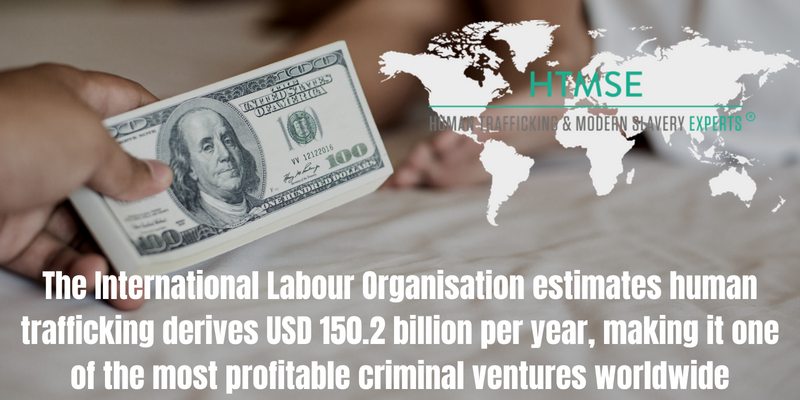
In parallel to the transatlantic slave trade as one of the most profitable business ventures in global history, modern slavery in the form of human trafficking follows suit. The International Labour Organisation estimates human trafficking derives USD 150.2 billion per year, making it still one of the most profitable criminal ventures worldwide. Furthermore, in an environment of globalisation it is rapidly increasing in numbers and in typologies. The rise in displacement and movement of people, whether in refuge from conflict zones, economic or environmental migration means there is increased vulnerability to trafficking, and in turn, more revenue produced by trafficking rings.
The Financial Action Task Force (FATF) and the Asia/Pacific Group on Money Laundering (APG) compiled a study Financial Flows From Human Trafficking to address the use of human trafficking as a source of money laundering and terrorist funding. Modern terror networks have indeed taken advantage of this profitable business venture, which creates a complex nexus between trafficking, money laundering and terror financing.
The report divides human trafficking into three categories in which revenue is produced through very unique money laundering systems. Firstly, trafficking for forced labour produces USD 51.2 billion per year, of which USD 43.40 billion is generated by hard labour exploitation, and USD 7.9 billion produced through domestic servitude. Second, trafficking for forced sexual exploitation produces USD 99 billion. Third, organ removal produces between USD 600 million – 1.2 billion, however the report refrains from providing a defined figure because the crime is rarely done in isolation, and therefore overlaps with other crimes which clouds the figures.
The aim of the FATF report is to provide “tangible indicators and best practices for national authorities to improve their effectiveness in combatting money laundering and terrorist financing from human trafficking”. In order to understand these systems appropriately, they provide a set of ‘money laundering indicators’ to be adopted by specialists and authorities working in the human trafficking sector, to create a systematic form of recording and analysing financial flows from trafficking. The report finds major issues that international actors have in disrupting the nexus between human trafficking, money laundering and terror financing, and outlines resolutions including the need to:
On analysis, the conclusions of this report put significant weight on the need for cooperation between international, state and regional authorities to work together in combatting financial flows from human trafficking. However, there are many challenges and complexities including the corruption of state actors that contribute to the global trafficking systems and obscure the financial figures recorded, including which revenue streams are being used for terror funding. The international institutions such as FATF need to work closely with governments to systematically identify and analyse this. By nature of the black market, accurate figures are impossible to find which inhibits the capacity of national authorities, financial institutions, NGOs and actors to prioritise responses to human trafficking in its various forms. Yet as we further understand the finances of the crime, we are able to respond with effective measures of prevention and resolution.
For the full FAFT report, Financial Flows From Human Trafficking read here.

The United Nations has allocated the World Day against Trafficking in Persons, occurring for the 5th year on July 30th, in order to raise awareness for the heinous crime that plagues every country globally, whether a place of origin, transit or final destination.
Behind drug trafficking, human trafficking is one of the most profitable criminal networks where millions of vulnerable people are forced, manipulated or coerced into moving to a foreign destination, whereby they will endure exploitation at some point along their path. This may take the form of hard labour, sexual exploitation, forced begging, forced criminality, organ removal or ever developing forms of exploitation, for example skin removal, online pornography, and exploitation in the sports industry.
The International Labour Organisation reports that 21 million people are subject to forced labour globally, of which a large proportion have been trafficked. Women and girls make up around 70%, and children or minors make up 30% of all trafficking victims. Hence, the focus for World Day against Trafficking in Persons 2018 is on ‘responding to the trafficking of children and young people’ as announced by the UNODC. The aim is on prevention, education, support and justice for the child victims of trafficking.
In order for this movement to be most effective, professionals within the fields of human trafficking and modern slavery need to work together, pool resources, expertise and specialism. The HTMSE directory is a global platform that lists professionals in the fields of law, trafficking and country experts, medical experts, counsellors and therapists, specialist organisations and researchers who are working towards the same goal of eradicating exploitation, trafficking and slavery. On this World Day against Trafficking in Persons 2018, we welcome you to join our initiative or use the resource in your fight against human trafficking alongside our professional network, to achieve support and justice for victims of trafficking.
For further information on World Day against Trafficking in Persons 2018, see here.

The crossing between North Africa and Southern Europe has proved to be the most dangerous refugee passage. Concern has been raised by international agencies including the IOM and UNHCR by two fatal sunken boats over three days at the beginning of July 2018.
On the first boat around 103 people drowned off the coast of Libya, where the coast guard had limited capacity to rescue only 16 men. The mode of transport in which they were crossing was an “unseaworthy and overcrowded” rubber boat marking an example of the dangerous methods that migrant smugglers are using. Shortly following, a second boat capsized with 100 people still missing, 41 saved. This toll contributes to the statistics of over 1000 drowning on the Mediterranean crossing of this year alone.
The Libyan Coast Guard is continually intercepting boats with smuggled migrants who are attempting to cross the Mediterranean and turning them back to be held in detention centres. Although numbers arriving at EU shores are 5 times lower than it’s peak in 2016, over 10,000 people have been returned to shore so far this year, representing another significant increase in numbers. There is also concern over the human rights conditions in the detention centres, where women and children put at high risk of violation and exploitation.
On analysis, although this points to urgent need for action by the EU, this situation needs to be addressed carefully. Bureaucracy between Geneva and the Libyan government led to the 2018 EU backed anti-smuggling operations in Libya including tightening regulation of volunteer boats arriving on European shores, which inadvertently has impacted the increased death toll. The concern of agencies is regarding higher sanctions on boats already in transit, which will bread further desperation and in turn fatal impact if distress calls are not seen to. Hence, emphasis should be made on reinforcing search and rescue operations, assist the Libyan coast guard and a careful and collaborative approach needs to be made with the international community to curb migrant smuggling and the cause of more deaths during this crossing.
It is also important to highlight the increase of displaced and vulnerable migrants who are at risk of exploitation, given the complexities of the migrants’ journey, it is a frequent occurrence that the definitions of trafficking and smuggling become obscured. Often victims will believe they are being smuggled but become trafficked through transit or at their destination country. Factors such as political instability, economic pressures and environmental issues are often the catalysts for migrants seeking to come to Europe. Illegal migrants often rely on organised criminal networks to facilitate their passage to Europe, leading to higher risk of exploitation and further blurring of the distinction between trafficking and smuggling. The migrant crisis in Libya provides a unique yet unfortunate opportunity for clarification: the controls aimed at ending the smuggling of migrants to Europe has been the catalyst of human trafficking inland.
For Untitled Nations reporting on the migrant crisis see here:

Polaris has recently investigated a structural cause into the increased trafficking statistics within the USA. From 2015-2017, around 50% of all victims who reported labour trafficking to the National Human Trafficking Hotline had legal employment visas, of whom 797 had specifically Temporary Work Visas (H-2A, H-2B). From their research, 75% of the victims were recruited for valid job offers within a variety of industries including agriculture, domestic work, landscaping, hospitality, restaurants, and construction.
This suggests that there is a disconnection between the legal framework that a temporary visa provides and the reality of employment, where a grey area allows employers to exploit their foreign workers. Indeed, Polaris’ latest report details how firstly, labour recruiters for the USA demand an array of complex fees and hidden costs often amounting to disproportionate debt for the victim. Furthermore, many of the visa holders are vulnerable to exploitation because they are legally bound to a single employer to uphold their right to remain in the USA. This often leads to a form of debt bondage to their employer because by loosing their job they are imminently subject to deportation, which can be used to blackmail and demand on-going labour.
Instead of the cause of this trafficking being rooted in the recruitment process that usually occurs abroad, the issue posed takes place at the next stage once employment is confirmed within a domestic situation. This must be looked at within the context of the USA border policy, which tends to be outward focused in an attempt to control inward trafficking of drugs, weapons and humans. However, these statistics suggest there is an oversight made domestically, with a need for regulation of labour policies for immigrants. Polaris suggests the need for transparency and supports the proposed Visa Transparency Anti-Trafficking (VTAT) bill to address this issue.
For the full Polaris Report on Human Trafficking on Temporary Work Visas, read here.
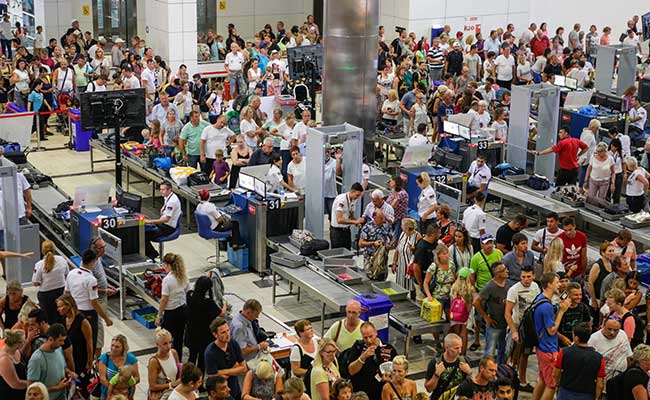
Human trafficking is a widespread network that utilises many forms and modes of transport; from dangerous fishing boats between North Africa and Europe to occurring in plain sight on commercial transport carriers. The International Air Transport Association (IATA) has the agenda to address trafficking of persons through the global air transport network, that flew 4 billion people around the world during 2017 alone.
The 74th IATA Annual General Meeting took place last week involving the UNODC, which led to all member airlines unanimously approving commitments to curb human trafficking facilitated by their airlines. The resolutions included:
The outcome of this meeting is a positive step in addressing trafficking through commercial airlines. The limitation, however, is with effective airline policing, traffickers will look to black market and alternative means of transport, which may be significantly more dangerous for the victim than travelling via conventional air transport.
For further reporting on the IATA Annual General Meeting, please read here.
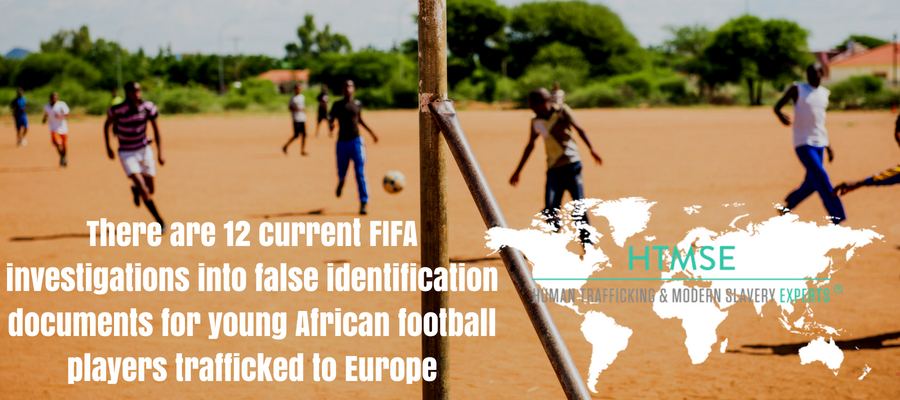
The exploitation of aspiring young African footballer players is being analysed as a rising channel of human trafficking. Boys on the West Coast of Africa, along with their families living in various degrees of poverty, are sold into a form of ‘debt bondage’ through the dream of playing for a European league, in which their fortunes would be immense. With premier European football transfers reaching 200 million Euros, the attaining a cut of this fee is being seen as a lucrative business opportunity. Following recent African football heroes such as Stephen Appiah, now a multimillionaire who began as an academy player of Ghana, there scouts from European clubs such as Paris Saint-Germain and Monaco looking for talented players within the developing world. Although aiming to provide opportunity for talented players, the chances of selection for the majority remain disproportionately slim as the selection process is based on a system of privilege and club prejudice. However, aspiration to these African football idols is used by local football ‘agents’ as a ‘realistic opportunity’ to leverage poor African families to spend their life savings and limited resources to pay agents from football academies around $3,000 per player to promise passage to Europe and signing by a big club.
In attempted replica of the few legitimate academies that successful African footballers used, a number of illegitimate clubs or unlicensed ‘academies’ have begun to develop mostly in Cote d’Ivoire and Ghana. Often, the agents themselves claim to be ex-pro players, yet have false resumes and limited knowledge of the game or the professional football selection process. In many cases they present binding contracts where agents are guaranteed a majority cut of their potential success, as well as require payment for all intermediate consultation and logistic services. Such fees are extortionate in relation to the families’ financial situation, where houses, family heirlooms, jewellery is often resorted to as payment. Furthermore, because of the devotion to this opportunity, boys are pulled out of education or any other form of skill development, which narrows their chance of economic prosperity in any other field.
The reality is that in many cases for these boys to get to Europe, they would have to be trafficked or smuggled by the agents via extremely dangerous routes, using illegal identification documentation obtained through domestic corruption. On arrival in Europe, given the illegitimacy of the clubs they come from, the chances of the players getting a professional trial are very slim. In some cases, they are provided with this opportunity, however as reported by Italian authorities, the fake documentation they have will jeopardise the opportunity for their selection – as seen by the current 12 investigations into FIFA rule violations for this purpose. Furthermore, if they do not succeed in their trial or become injured, the young boys are commonly abandoned or refuse to return home because of the shame to their families. This form of trafficking is a growing epidemic as the footballers are left homeless, poor and resorting to street trading or petty crime. The agents are exploiting families by selling them false hope, because despite the world-class skill and potential of the players, the probability of their success through these illegitimate channels is highly unlikely.